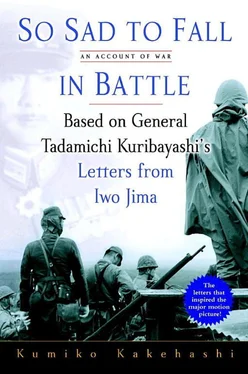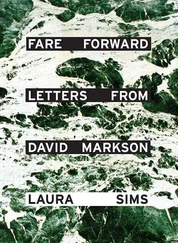Iwo Jima was not just a remote place; you were unlikely to make it back home alive. Many other generals came up with excuses to wriggle out of being sent there and, in a sense, Kuribayashi was the only one foolishly honest enough to say yes. Once he had accepted, he fulfilled his duty heroically, as I hope this book shows. In matters of war, Kuribayashi was a rationalist, but when it came to his life philosophy, he had an almost naive conviction that a soldier’s duty was to go out to the front lines and put himself in harm’s way.
An examination of Kuribayashi’s experiences on Iwo Jima reveals such a gulf between the men who risked their lives on the front and the top brass who were responsible for overall direction of the war that one is reluctant to apply the word “soldier” to both groups. The staff officers ensconced in the safety of the Imperial General Headquarters did not even try to find out how the war was really progressing, but just drew lines on a map and declared: “Such-and-such place must be defended to the death.” Kuribayashi was on the receiving end of those orders, and he was the one who went out to an isolated and unsupported battle zone.
In February 1994, the first Japanese emperor to set foot on Iwo Jima composed a poem there.
The men who fought heart and soul,
Still sleep beneath the ground
On this sad isle.
The central command may have written the island off, but Kuribayashi’s twenty thousand plus men were still determined to do their duty as best they could and put up a formidable fight. Each and every one of them truly “fought heart and soul.”
The emperor’s poem and Kuribayashi’s death poem in his farewell telegram are linked by a common word: “sad,” the very word that the Imperial General Headquarters chose to alter, changing “so sad we fall” to “mortified we fall.”
It is no coincidence. After the passage of forty-nine years, the emperor of a new and different epoch acknowledged Kuribayashi’s fine poem. And he did it on the sands of Iwo Jima, the very place where Kuribayashi wrote about the sadness of the soldiers going to their deaths.
THE KURIBAYASHI FAMILY GRAVE stands in Takitanzan Meitokuji Temple not far from the house where Kuribayashi was born. Meitokuji is an ancient temple, and generation after generation of Kuribayashis have served as parish representatives.
Naotaka took me to the cemetery. After we passed through the quiet temple precincts, the cemetery spread out before us ringed by the fresh foliage of trees. The mountain onto which the cemetery backs is Mount Minakami, which contains the ruins of the Matsushiro Imperial Headquarters.
The Matsushiro Imperial Headquarters is an underground bunker complex. It was built to accommodate the Imperial General Headquarters, the Imperial family, government ministries and agencies, and the national broadcaster, all of whom were to move out of Tokyo before the decisive battle for the homeland. Construction began in November 1944 at Mount Zô and Mount Maizuru as well as Minakami and continued without a single day’s pause until August 15, 1945.
At exactly the same time Kuribayashi was working frantically to dig his underground bunkers on Iwo Jima, another large-scale bunker complex was being excavated in the very place where he had been born and raised. Both were expected to save the nation.
The plan to move Imperial General Headquarters to Matsushiro was top secret. The words “Imperial General Headquarters” do not appear anywhere on the original blueprints; instead, the facility is called “Matsushiro Storage Space.” Kuribayashi, however, seems to have known what was going on, as this passage from his November 28, 1944, letter to his elder brother, Yoshima, suggests: “As regards the military facility at Mount Minakami, they are starting to implement a plan, which was pending until recently. I think it extremely unlikely that the enemy will bomb the area.”
Standing in front of Kuribayashi’s grave, you can see Mount Minakami off to the right. Peaceful and dripping with lush green, it is hard to believe that within its womb is a vast, dark cave fathered by war.
His grave is simple: an ordinary rectangular upright stone on which the words “The Grave of General Kuribayashi Tadamichi” are carved. There is also a single sentence from a letter dated January 12, 1945, that I had just been allowed to read: the last letter he sent to his brother Yoshima in the house where he had been born: “Finally, should the worst come to the worst, I don’t mind where my grave is located. A single stone shaft with the words ‘The Grave of Lieutenant General Kuribayashi Tadamachi’ is all I need.”
There was a holder for name cards beside the grave. It contained two cards. The families of the men who lost their lives on Iwo Jima still come to pay their respects. Few of them visit the Kuribayashi house, but they all offer incense and prayer. The soldiers on Iwo Jima came from all over Japan, and the addresses on the two cards were both from Kanagawa Prefecture near Tokyo.
The present head of the Kuribayashi family, whose great-uncle was an illustrious general, picked up the cards, brushed a thin film of dust off them with his finger, and tucked them neatly into his breast pocket.
I visited Tarô, Kuribayashi Tadamichi’s son, in the autumn of 2003 for the simple reason that a single phrase in one of the letters from Iwo Jima really spoke to me. My research for this book dates from when Tarô welcomed me, a complete stranger, with such warmth, and let me handle and read the letters he had so carefully preserved. Tarô passed away on March 24, 2005, at the age of eighty. I am sorry that he was unable to read the completed book.
I interviewed Tarô’s younger sister, Shindô Takako, several times from late 2003 to early 2004. Takako, who sang me “The Moon in the Rain” and “The Sky of Home,” also passed on, about six months after that, at the age of sixty-nine. They both provided me with precious information and encouraged me in my writing. I thank them from my heart.
I belong to a generation ignorant of war. I was only able to write about this poorly documented battle thanks to the numerous people who helped me with my research, including the Association of Iwo Jima, the survivors who wrote accounts of their experiences, and professional historians of Iwo Jima. I take this opportunity to thank you all very much.
Last of all, speaking as one of the following generation, I would like to express my respect and gratitude for everyone who took part in the war and endured indescribable hardships before dying far away from their homes.
Kuribayashi Tarô; Kuribayashi Fumiko; Kuribayashi
Naotaka; Kuribayashi Hideko; Kuribayashi Kaoru; Kuribayashi
Toshinori; Kuribayashi Kazuko; Kuribayashi Matsue; Shindô
Takako; Sadaoka Nobuyoshi; Ôkoshi Harunori; Yamagiwa
Yoshikazu; Egawa Mitsue; Egawa Jun; Kobayashi Michiko;
Tanaka Kenichi; Fushiwara Takahiro; Shishikura
Madoka; Shishikura Eiko; Nozu Naoko; Suwabe
Junichirô; Nakamura Tadanori; Tamura Akiko.
Bôeichô Bôeikenshûjo Senshishitsu. Senshisôsho ChûbuTaiheyô Rikugun Sakusen 2 Periryû• Angauru• Iô-Jima. Asagumo Shimbunsha
———. Senshisôsho Daihonei Rikugunbu 10 Shôwa nijû-nen hachi-gatsu made. Asagumo Shimbunsha
———. Senshisôsho Daihonei Kaigunbu/Rengô Kantai 7 Sensô Saishûki. Asagumo Shimbunsha
Rikusenshi Kenkyû Fukyûkai Hen. Rikusenshishû 15 Dainijisekaitaisen-shi Iô-Jima Sakusen. Hara Shobô
Iô-Jima Kyôkai Kaihô , Nos. 1–35. Iô-Jima Kyôkai
Читать дальше












